January 14, 2015 report
Canadian fossil discoveries offer clues to early evolution in upper North America
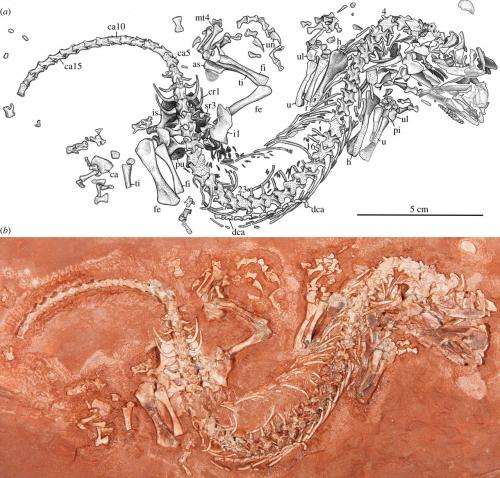
(Phys.org)—Two different teams of researchers are reporting on fossil findings in Canada—one describes a 300 million year old reptile found over a decade ago, the other an ancient scorpion that appears to have climbed out of the sea and onto land to molt. Teams have published their findings in the Royal Society journals Biology Letters and Proceedings of the Royal Society B.
The reptile fossil was first discovered by a young boy on the family farm on Prince Edward Island, approximately 14 years ago. Sometime thereafter it made its way to the Royal Ontario Museum and into the hands of a research team led by Sean Modesto. They report that the fossil, (which is approximately 19 centimeters in length) and described as lizard-like, and which they have named erpetonyx arsenaultorum, is in excellent shape, and represents the oldest sample ever found of early reptiles called bolosaurids parareptiles. It also suggests, the team notes, that the diversity of reptiles living during the end of the Carboniferous was more diverse than has been thought. The finding has researchers wondering what else might be hiding beneath the famous red stone found on the island.
More intriguing perhaps was the discovery of 11 molted exoskeletons of an early type of scorpion found hidden in ancient sediment on the Bruce Peninsula in southwestern Ontario—they are believed to have lived 430 million to 433 million years ago—a time before creatures crawled out of the ocean and settled on land. That is what makes the find so exciting, the furthermost part of their limbs—the last segments—were shorter than those of other earlier scorpion relatives, and reminiscent of the foot of modern day scorpions, indicating that that the creatures climbed out of the water onto land to molt.
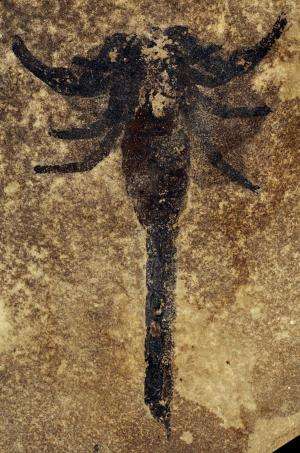
Such an evolutionary change would have also necessitated other physical changes to allow for supporting its own weight out of water. The researchers note that doing so would make sense, scorpions are particularly vulnerable to predators during and shortly after molting—climbing onto land would offer a safe refuge, and evidence of one of the first examples of a creature beginning the journey from the sea onto land.
-
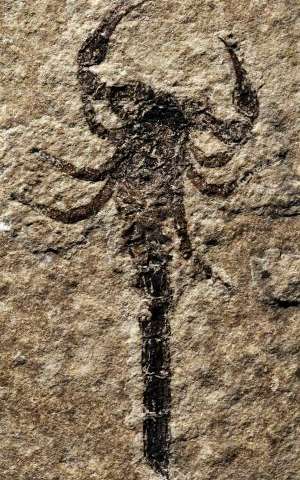
Credit: © David Rudkin, Royal Ontario Museum. -
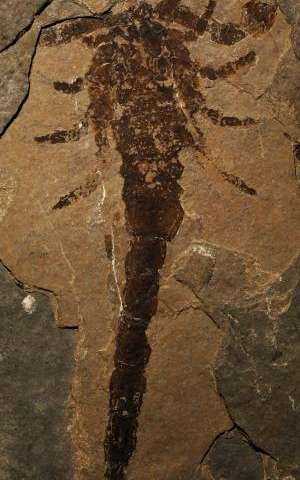
Credit: © David Rudkin, Royal Ontario Museum. -
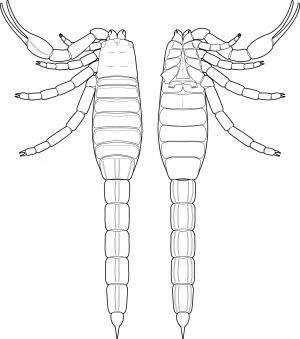
Credit: © David Rudkin, Royal Ontario Museum.
More information: A new mid-Silurian aquatic scorpion—one step closer to land? Biology Letters, Published 14 January 2015. DOI: 10.1098/rsbl.2014.0815
Abstract
One of the oldest known fossil scorpions, a new species from the mid-Silurian Eramosa Formation (430 myr) of Ontario, Canada, exhibits several surprising features. The depositional environment and associated biota indicate a marine habitat; however, the leg morphology of this scorpion, which has a short tarsus in common with all Recent scorpions, suggests that a key adaptation for terrestrial locomotion, the ability to support its weight on a subterminal 'foot', appeared remarkably early in the scorpion fossil record. Specimens are preserved intact and undisturbed in a splayed posture typical of moults rather than carcasses. We postulate that these animals were aquatic, but occasionally ventured into extremely shallow water, or onto a transient subaerially exposed surface while moulting, before returning to deeper water. Shed exuviae were preserved in situ by rapid overgrowth of bacterial biofilm.
The oldest parareptile and the early diversification of reptiles, Proceedings of the Royal Society B, Published 14 January 2015. DOI: 10.1098/rspb.2014.1912
Abstract
Amniotes, tetrapods that evolved the cleidoic egg and thus independence from aquatic larval stages, appeared ca 314 Ma during the Coal Age. The rapid diversification of amniotes and other tetrapods over the course of the Late Carboniferous period was recently attributed to the fragmentation of coal-swamp rainforests ca 307 Ma. However, the amniote fossil record during the Carboniferous is relatively sparse, with ca 33% of the diversity represented by single specimens for each species. We describe here a new species of reptilian amniote that was collected from uppermost Carboniferous rocks of Prince Edward Island, Canada. Erpetonyx arsenaultorum gen. et sp. nov. is a new parareptile distinguished by 29 presacral vertebrae and autapomorphies of the carpus. Phylogenetic analyses of parareptiles reveal E. arsenaultorum as the closest relative of bolosaurids. Stratigraphic calibration of our results indicates that parareptiles began their evolutionary radiation before the close of the Carboniferous Period, and that the diversity of end-Carboniferous reptiles is 80% greater than suggested by previous work. Latest Carboniferous reptiles were still half as diverse as synapsid amniotes, a disparity that may be attributable to preservational biases, to collecting biases, to the origin of herbivory in tetrapods or any combination of these factors.
Journal information: Proceedings of the Royal Society B , Biology Letters
© 2015 Phys.org





















